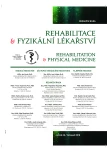Application of the Concept of Auto-Reflex Connection of Deep Stabilization System after Surgery on Hernia of Intervertebral Disc in Lumbar Spine Treatment of Multiple Sclerosis from the Point of View of Rehabilitation
Authors:
J. Miľanová 1; E. Žiaková 2; K. Hornáček 3
Authors‘ workplace:
Špecializovaný liečebný ústav Marína š. p., Kováčová
1; Katedra fyzioterapie, Inštitút fyzioterapie, balneológie a liečebnej rehabilitácie, Univerzita sv. Cyrila a Metoda v Trnave
2; Katedra fyziatrie balneológie a liečebnej rehabilitácie, Lekárska fakulta, Slovenská zdravotnícka univerzita v Bratislave
3
Published in:
Rehabil. fyz. Lék., 26, 2019, No. 4, pp. 157-165.
Category:
Original Papers
Overview
Physiotherapeutic intervention in patients after surgery on hernia of intervertebral discs is oriented to improvement of functional state of locomotor apparatus by using various classical and modern methods of kinesiotherapy and physical treatment. The aim of the article is to describe the therapeutic concept of Autoreflex (auto-reflex) connection (AZH) – prenatal, postnatal therapeutic positions and its application in patients after surgery on intervertebral discs in the lumbar spine. In the casuistic study the authors documented a positive influence of AZS on functional state of locomotor apparatus in a 38 years old female patient after surgery on intervertebral disc in the lumbar spine during spa therapy.
Objectification of the selected method of kinesiotherapy was made by functional test of mobility of the spine, examination of function of the deep stabilization system (HSS), by a tonometer, examination of somatognosia, examination of symmetry of loading lower extremities (DKK) on two weighing machines. Changes of body holding (place upright) was objectified by a diagnostic software Body Analyzer. In evaluating of results of the work the authors documented improvement of the HSS function and postural stability in vertical direction, improved symmetry of the loading of lower extremities, improved quality of subjective perception of the patient’s own body and improved spine mobility. The AZH method is contributive for kinesiotherapy of patients after surgery on intervertebral discs in lumbar spine.
Keywords:
Physiotherapy – auto-reflex connection of the deep stabilization system – intervertebral disc hernia
Sources
1. CHAMBERLAIN, D.: Fascinující mysl novorozeného dítěte. Praha, Beta Books, 2013, s. 40-82.
2. DYLEVSKÝ, I.: Obecná kineziologie. Grada Publishing, 2007, s. 43-62.
3. DYLEVSKÝ, I.: Kineziologie: Základy strukturální kineziologie. Praha, Triton, 2009, s. 120-201 235.
4. DYLEVSKÝ, I.: Dětský pohybový systém. Olomouc, Poznání, 2012, s. 152.
5. FEDOR–FREYBERG, P. G.: Prenatálne dieťa. Trenčín, Vydavateľstvo F, 2013, s. 65.
6. GÚTH, A. a kol.: Vyšetrovacie metodiky v rehabilitácii. Bratislava, Liečreh, 2016, s. 169-183.
7. HOLAŇOVÁ, R. a kol.: Cílená kinezioterapie po operaci bederní páteře z časového hlediska a příklad jejího efektu u konkrétní pacientky. Rehabilitácia, roč. 46. 2009, č. 4, s. 222–227.
8. HORNÁČEK, K.: AZH. Rehabilitácia, roč. 53, 2016, č. 3, s. 183-184.
9. JABLONSKÁ, H.: Využitie diagnostického softwaru Body Analyzer pri určovaní posturálnych porúch. Bakalárska práca, Banská Bystrica, SZU, 2014, s. 63.
10. JABLONSKÝ, P.: Manual pre program Body Analyzer. [online]. 2014 [cit. 2017-7-12]. Dostupné na internete: <http://body-analyzer.com/files/body-analyzer-manual.pdf>.
11. KOLÁŘ, P. a kol.: Rehabilitace v klinické praxi. Praha, Galén, 2009, s.230-292.
12. KOŠINOVÁ, Ľ. a kol.: Autoreflexné zapojenie hlbokého stabilizačného systému (HSS) prenatálne a postnatálne terapeutické polohy. Rehabilitácia, roč. 51, 2014, č. 4, s. 195-199.
13. KOŠINOVÁ, Ľ. a kol.: Autoreflexné zapojenie hlbokého stabilizačného systému. Rehabilitácia, roč. 50, 2013, č. 1, s. 3-6.
14. KOŠINOVÁ, Ľ.: Autoreflexné zapojenie HSS prenatálne, postnatálne terapeutické polohy, kurz 2. časť, Kováčová, 13. 1. 2017 - 15. 1. 2017, lektor Košinová Ľ.
15. KOŠINOVÁ, Ľ. a kol.: Autoreflexné zapojenie HSS prenatálne, postnatálne terapeutické polohy. Banská Bystrica, Koprint, 2016, s. 5-9.
16. ORTH, H.: Dítě ve Vojtově terapii. České Budějovice, Kopp, 2012, s. 53-100.
17. PALAŠČÁKOVÁ ŠPRINGROVÁ: Funkce – diagnostika – terapie hlubokého stabilizačního systému. Rehaspring, 2010, s. 32-51.
18. RUDINSKÝ, B., KOLEJÁK, K.: Degeneratívne ochorenie driekovej chrbtice, možnosti chirurgickej liečby. Neurológia pre prax roč. 9, 2008, č. 3, s. 135-141.
19. ŽIAKOVÁ, E., MUSILOVÁ, E.: Vybrané kapitoly z fyzioterapie a ergoterapie. Bratislava, SZU, 2012, s. 15-21.
Labels
Physiotherapist, university degree Rehabilitation Sports medicineArticle was published in
Rehabilitation & Physical Medicine

2019 Issue 4
Most read in this issue
- Application of the Concept of Auto-Reflex Connection of Deep Stabilization System after Surgery on Hernia of Intervertebral Disc in Lumbar Spine Treatment of Multiple Sclerosis from the Point of View of Rehabilitation
- Biofeedback and Its Application if Therapeutic Rehabilitation of Human LocomotorSystem
- Is the Stationary Bicycle a Suitable Supplement of Physiotherapy in Vertebrogenic Difficulties?
- The Influence of Training on Maximum Performance and Shoulder Pain in Flatwater Kayak-Paddlers
